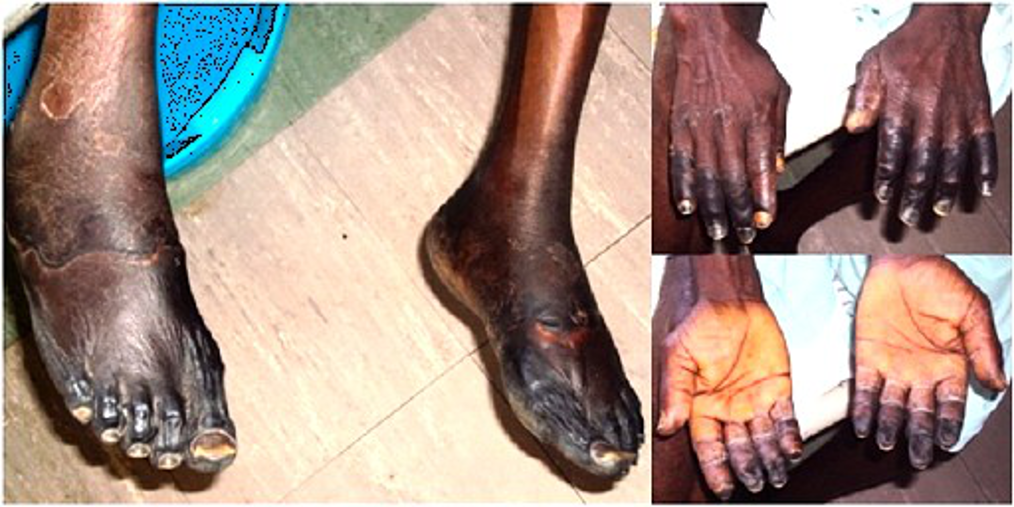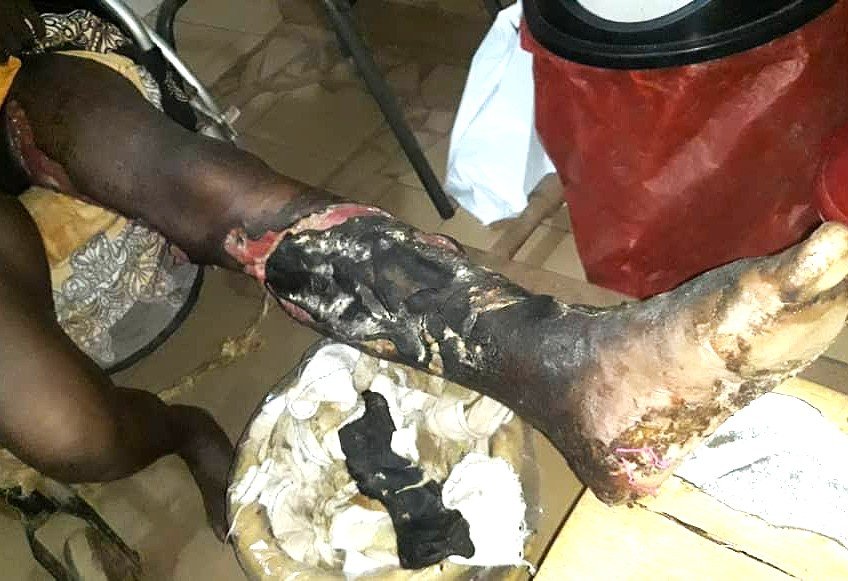
What is the diabetic foot (or hand)?
Diabetic foot refers to foot problems that arise in people with diabetes due to poor blood circulation and nerve damage (neuropathy). It can lead to infections, ulcers, and in severe cases, gangrene or amputation.
Diabetic foot is a common and serious complication in sub-Saharan Africa (SSA), where delayed treatment often leads to severe outcomes. In many cases, the hands may also be affected (and shown in the above picture)
Causes of Type 2 Diabetes
- Nerve damage (Diabetic Neuropathy): High blood sugar levels can damage nerves, particularly in the feet, leading to numbness or loss of sensation. This means injuries or ulcers may go unnoticed, worsening over time.
- Poor blood circulation (Peripheral Artery Disease): Diabetes can cause blood vessels to narrow and harden, reducing blood flow to the feet. This makes it harder for wounds or infections to heal, increasing the risk of gangrene.
- Foot (or hand) deformities: Neuropathy can cause changes in the shape of the foot, increasing the risk of pressure sores and ulcers.
- Infections: Reduced blood flow and high glucose levels make it easier for bacteria to thrive, leading to infections that can spread rapidly.
The natural history of the disease - Without effective treatment
If untreated, a small injury on the foot can develop into an ulcer or infection. Without proper care, the infection can spread to deeper tissues, bones, and joints, leading to gangrene.
In severe cases, amputation may be necessary to prevent the infection from spreading further. Early detection and treatment are key to preventing these complications.
How is the diabetic foot managed - Treated?
Here are the most important measures in the management of a diabetic foot:
- Foot Care: Proper foot hygiene is crucial. Patients must wash their feet daily, check for any injuries, blisters, or infections, and keep the feet moisturized to prevent cracking.
- Wound Care: Any cuts or blisters should be treated immediately with antiseptics, and medical attention should be sought to prevent infection.
- Offloading Pressure: Special shoes, insoles, or devices can help distribute weight and reduce pressure on vulnerable areas, preventing ulcers from worsening.
- Medications: Antibiotics may be needed to treat infections, and in some cases, surgical debridement (removal of dead tissue) is necessary to promote healing.
- Blood Sugar Control: Keeping blood sugar levels within a healthy range is critical for preventing and managing diabetic foot.
Key Risk Factors
- Uncontrolled Diabetes: Poorly managed blood sugar levels increase the risk of neuropathy and poor circulation.
- Smoking: Smoking damages blood vessels, further reducing circulation in the feet.
- Previous Foot Ulcers or Amputations: Having a history of foot ulcers or amputations raises the risk of future complications.
Consequeces if untreated or poorly managed
Poorly managed, the diabetic foot )or hand will lead to any or all of the folloing:
- Ulcers: Open sores that can become infected and difficult to heal.
- Infections: Severe infections may require antibiotics, hospitalization, or surgery to remove dead tissue.
- Gangrene: Untreated infections can lead to gangrene (tissue death), which may require amputation.
- Amputations: Diabetic foot is a leading cause of lower-limb amputations in SSA. Early detection and treatment can prevent this outcome.
The tragedy of a neglected diabetic foot in rural Africa: advanced foot gangrene

A diabetic patient with an amputated left leg: the inevitable consequence of a poorly managed diabetes

The most important actions needed to be taken
For Diabetic Patients:
- Check your feet daily: Look for cuts, blisters, redness, swelling, or signs of infection.
- Control your blood sugar: Maintain healthy blood sugar levels to prevent nerve damage and poor circulation.
- Wear protective footwear: Choose shoes that fit well and protect your feet from injury.
- Seek immediate treatment: If you notice any changes in your feet, consult a healthcare professional immediately to prevent complications.
- Quit smoking: This improves circulation and reduces the risk of complications.
For Caregivers:
- Assist with foot care: Help the patient check their feet daily and encourage proper hygiene.
- Ensure regular medical check-ups: Make sure the patient attends regular diabetes check-ups and foot screenings.
- Encourage healthy habits: Support the patient in maintaining a healthy diet, blood sugar control, and wearing appropriate footwear.
Remember
Diabetic foot can be prevented with proper foot care, early detection, and effective diabetes management.
For those already affected, taking swift action and seeking medical care is essential to avoid serious complications, including amputations.
Both patients and caregivers have a vital role in ensuring diabetic feet are properly cared for, preventing severe outcomes, and promoting healing.


